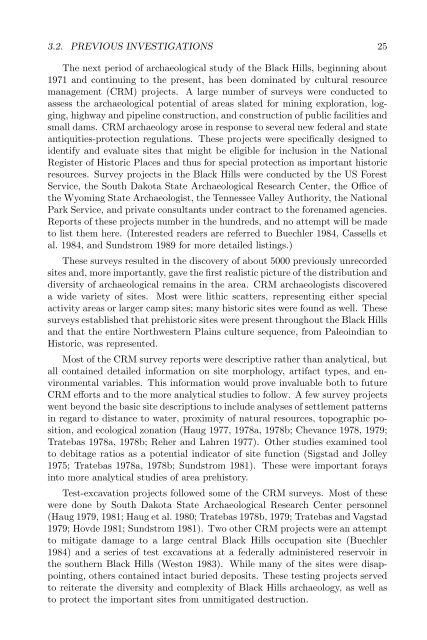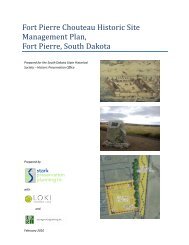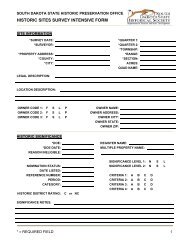The Blaine Site - South Dakota State Historical Society
The Blaine Site - South Dakota State Historical Society
The Blaine Site - South Dakota State Historical Society
You also want an ePaper? Increase the reach of your titles
YUMPU automatically turns print PDFs into web optimized ePapers that Google loves.
3.2. PREVIOUS INVESTIGATIONS 25<br />
<strong>The</strong> next period of archaeological study of the Black Hills, beginning about<br />
1971 and continuing to the present, has been dominated by cultural resource<br />
management (CRM) projects. A large number of surveys were conducted to<br />
assess the archaeological potential of areas slated for mining exploration, logging,<br />
highway and pipeline construction, and construction of public facilities and<br />
small dams. CRM archaeology arose in response to several new federal and state<br />
antiquities-protection regulations. <strong>The</strong>se projects were specifically designed to<br />
identify and evaluate sites that might be eligible for inclusion in the National<br />
Register of Historic Places and thus for special protection as important historic<br />
resources. Survey projects in the Black Hills were conducted by the US Forest<br />
Service, the <strong>South</strong> <strong>Dakota</strong> <strong>State</strong> Archaeological Research Center, the Office of<br />
the Wyoming <strong>State</strong> Archaeologist, the Tennessee Valley Authority, the National<br />
Park Service, and private consultants under contract to the forenamed agencies.<br />
Reports of these projects number in the hundreds, and no attempt will be made<br />
to list them here. (Interested readers are referred to Buechler 1984, Cassells et<br />
al. 1984, and Sundstrom 1989 for more detailed listings.)<br />
<strong>The</strong>se surveys resulted in the discovery of about 5000 previously unrecorded<br />
sites and, more importantly, gave the first realistic picture of the distribution and<br />
diversity of archaeological remains in the area. CRM archaeologists discovered<br />
a wide variety of sites. Most were lithic scatters, representing either special<br />
activity areas or larger camp sites; many historic sites were found as well. <strong>The</strong>se<br />
surveys established that prehistoric sites were present throughout the Black Hills<br />
and that the entire Northwestern Plains culture sequence, from Paleoindian to<br />
Historic, was represented.<br />
Most of the CRM survey reports were descriptive rather than analytical, but<br />
all contained detailed information on site morphology, artifact types, and environmental<br />
variables. This information would prove invaluable both to future<br />
CRM efforts and to the more analytical studies to follow. A few survey projects<br />
went beyond the basic site descriptions to include analyses of settlement patterns<br />
in regard to distance to water, proximity of natural resources, topographic position,<br />
and ecological zonation (Haug 1977, 1978a, 1978b; Chevance 1978, 1979;<br />
Tratebas 1978a, 1978b; Reher and Lahren 1977). Other studies examined tool<br />
to debitage ratios as a potential indicator of site function (Sigstad and Jolley<br />
1975; Tratebas 1978a, 1978b; Sundstrom 1981). <strong>The</strong>se were important forays<br />
into more analytical studies of area prehistory.<br />
Test-excavation projects followed some of the CRM surveys. Most of these<br />
were done by <strong>South</strong> <strong>Dakota</strong> <strong>State</strong> Archaeological Research Center personnel<br />
(Haug 1979, 1981; Haug et al. 1980; Tratebas 1978b, 1979; Tratebas and Vagstad<br />
1979; Hovde 1981; Sundstrom 1981). Two other CRM projects were an attempt<br />
to mitigate damage to a large central Black Hills occupation site (Buechler<br />
1984) and a series of test excavations at a federally administered reservoir in<br />
the southern Black Hills (Weston 1983). While many of the sites were disappointing,<br />
others contained intact buried deposits. <strong>The</strong>se testing projects served<br />
to reiterate the diversity and complexity of Black Hills archaeology, as well as<br />
to protect the important sites from unmitigated destruction.
















